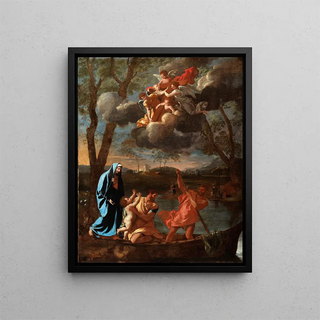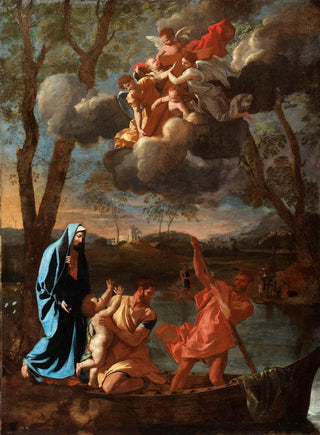Art print | The Return of the Holy Family to Nazareth - Nicolas Poussin


View from behind

Frame (optional)
Art print Le retour de la Sainte Famille à Nazareth - Nicolas Poussin – Captivating Introduction
In the vibrant universe of baroque art, Nicolas Poussin's work, "Le retour de la Sainte Famille à Nazareth," stands out for its narrative depth and technical mastery. This iconic canvas, which depicts the journey of the Holy Family after their visit to the Jerusalem temple, invites viewers to reflect on spirituality and daily life. Poussin, as a pioneer of classicism, manages to blend human emotion with a rigorous composition, creating a scene that is both intimate and universal. The piece, at once simple and complex, transports us to a moment of grace where the divine and the human meet.
Style and uniqueness of the work
Poussin's style is characterized by geometric precision and a color palette that evokes an atmosphere of serenity. In "Le retour de la Sainte Famille à Nazareth," each character is carefully positioned, creating a harmonious dynamic within the composition. The drapery of the clothing, with remarkable delicacy, almost seems alive, while the expressions on the faces reveal a range of deep emotions. The subtly orchestrated light plays a crucial role in highlighting details and guiding the viewer's gaze through the scene. Poussin succeeds in capturing not only the physical movement of the characters but also the depth of their spiritual experience, making the work surprisingly modern.
The artist and his influence
Nicolas Poussin, born in 1594, is often regarded as the father of French classicism. His artistic vision, rooted in the ideals of antiquity and the Renaissance, profoundly influenced the development of European art. Moving away from the excesses of baroque, Poussin advocates for a more intellectual and thoughtful approach to painting. His work "Le retour de la Sainte Famille à Nazareth" perfectly illustrates this philosophy, offering a clear and structured narration while incorporating elements of classical culture. Poussin's influence has been felt through the centuries, inspiring artists such as Claude Lorrain and, later,

Matte finish

View from behind

Frame (optional)
Art print Le retour de la Sainte Famille à Nazareth - Nicolas Poussin – Captivating Introduction
In the vibrant universe of baroque art, Nicolas Poussin's work, "Le retour de la Sainte Famille à Nazareth," stands out for its narrative depth and technical mastery. This iconic canvas, which depicts the journey of the Holy Family after their visit to the Jerusalem temple, invites viewers to reflect on spirituality and daily life. Poussin, as a pioneer of classicism, manages to blend human emotion with a rigorous composition, creating a scene that is both intimate and universal. The piece, at once simple and complex, transports us to a moment of grace where the divine and the human meet.
Style and uniqueness of the work
Poussin's style is characterized by geometric precision and a color palette that evokes an atmosphere of serenity. In "Le retour de la Sainte Famille à Nazareth," each character is carefully positioned, creating a harmonious dynamic within the composition. The drapery of the clothing, with remarkable delicacy, almost seems alive, while the expressions on the faces reveal a range of deep emotions. The subtly orchestrated light plays a crucial role in highlighting details and guiding the viewer's gaze through the scene. Poussin succeeds in capturing not only the physical movement of the characters but also the depth of their spiritual experience, making the work surprisingly modern.
The artist and his influence
Nicolas Poussin, born in 1594, is often regarded as the father of French classicism. His artistic vision, rooted in the ideals of antiquity and the Renaissance, profoundly influenced the development of European art. Moving away from the excesses of baroque, Poussin advocates for a more intellectual and thoughtful approach to painting. His work "Le retour de la Sainte Famille à Nazareth" perfectly illustrates this philosophy, offering a clear and structured narration while incorporating elements of classical culture. Poussin's influence has been felt through the centuries, inspiring artists such as Claude Lorrain and, later,






